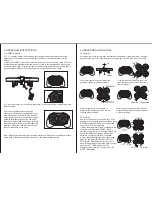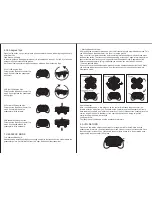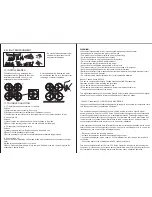
WARNING:
* Consumer is responsible for any injuries caused while using this quadcopter
* Keep body parts away from this product while in use
* This product is not suitable for children under 8 years of age
* Small parts included; keep away from children
* Check the charger, wire, plugs and other parts regularly
* Only use the charger included with this product
* Dinconnect the charger included with this model
* Never short circuit batteries, disassemble or throw in fire
* This product may vary from the illustrations on the package or this manual
* Keep the package and manual, as they contain useful information
* Batteries of different types or capacities shall not be mixed within any single electrical circuit.
* Do not mix old and new batteries.
* Do not mix alkaline, standard(carbon-zinc), or re-chargeable batteries.
Industry Canada Notice RSS210
This device complies with Industry Canada license-exempt RSS standard(s).
Operation is subject to the following two conditions:
(1) this device may not cause interference, and
(2) this device must accept any interference, including interference that may
cause undesired operation of the device.
M
AX
II
M
AX
II
11.1 Transmitter and quadcopter are not paired.
Solution :
1) Ensure pairing was successful. If not, re-try.
2) Double check whether the installation of the blades is correct.
3) Confirm that the remote control is the original match. If not, re-start and then re-pair.
11.2 Unable to flip
Solution :
1) Press function combination button, which will change to flip mode.
2)Check if Li-po (battery) power is too low and needs to be recharged.
11.3 Quadcopter is shaking with noise :
Solution :
1) battery voltage is too low. Replce the battery with a new one.
2)Power OFF the quadcopter then restart.
3)Put the quadcopter on a level horizontal plane and recalibrate the gyroscope.
11.4 Cannot take off :
Solution :1)Wrong installation of the blade. Make sure the blades are connected to the right
motor.
2)Make sure quadcopter’s shell is not loose.
3)Check if the quadcopter battery is fully charged. If battery is too low, the inner light on the
quadcopter’s shell will flash.
The blades need to be installed in their
designated location. Blade A/B should be
installed to marked A/B on body or the
quadcopter will not operate properly.
Hold the head aiming towards the motor
axis and press down to lock. Be careful not
to damage or deform the blades.
Do not operate quadcopter under
bad weather conditions to avoid
any potential damages.
9. FLIGHT EMVIRONMENT :
10. INSTALL BLADES :
11. TRUOBLE SHOOTING
undesired operation.
This digital apparatus does not exceed the Class B limits for radio noise emissions from digital
apparatus set out in the Radio Interference Regulations of Industry Canada.
The 2.4G Transmitter, FCC ID:Z3CWECCAN-RCDRONE
changes or modifications not expressly approved by the party responsible for compliance could
void the user’s authority to operate the equipment.
This equipment has been tested and found to comply with the limits for a Class B digital
device, pursuant to Part 15 of the FCC Rules. These limits are designed to provide reasonable
protection against harmful interference in a residential installation. This equipment generates,
uses and can radiate radio frequency energy and, if not installed and used in accordance with
the instructions, may cause harmful interference to radio communications. However, there is
no guarantee that interference will not occur in a particular installation.
If this equipment does cause harmful interference to radio or television reception, which can be
determined by turning the equipment off and on, the user is encouraged to try to correct the
interference by one or more of the following measures:
-- Reorient or relocate the receiving antenna.
-- Increase the separation between the equipment and receiver.
-- Connect the equipment into an outlet on a circuit different from that to which the receiver is
connected.
-- Consult the dealer or an experienced radio/TV technician for help.
This device complies with Part 15 of the FCC Rules. Operation is subject to the following two
conditions: (1) this device may not cause harmful interference, and (2) this device must accept
any interference received, including interference that may cause









